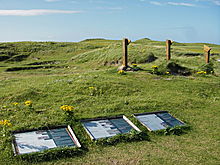|
|
|
|
Cladh Hallan Round HousesAncient Village / Settlement / Misc. Earthwork
|
||||||||||||||||||||||||
|
|
|
News |
|
Prehistoric mummy puzzleFrom Planet Earth Online: Mummified bodies made of chopped up people? It's not a legend from ancient Egypt but a find from the Outer Hebrides... continues... |
 Posted by baza
Posted by baza22nd January 2013ce Edited 22nd January 2013ce |
Images (click to view fullsize) |
|





















|
Fieldnotes |
|
|
Most people will now find the now well sign posted Cladh Hallan Round Houses and excellent they are. Walk to the north west and look for a gap in the dunes. Situated in this gap is another roundhouse gradually appearing or vanishing. A double course of stonework remains on the southside and a single course of stonework marks the rest of the site. In nearby dunes stones are poking out so it would come as no surprise that other sites might one day discovered. Further up the coast, a site has vanished. Visited 07/08/2023. |
1st January 2024ce |
|
Visited 16 August 2012ce while cycle-touring in the Outer Hebrides. Just to pick up on greywether's comment about signposting, there is now a proper brown "tourist" sign on the B888 road in Dalabrog / Daliburgh to direct interested parties to the roundhouses, though as seems to be the norm on the islands this gives no indication of distance! After following a minor road / track almost to the modern-day burial ground of Cladh Hallan, a further footpath-style sign points the way to the roundhouses which lie a few minutes walk along a sandy track. As for the roundhouses themselves, the southernmost has almost completely disappeared back into the dunes, but the central and northern houses are still visible as is the "smokery" just to the NE of the latter. Three interpretation boards have at some stage been set up on the rise overlooking the site from the N, but these have become detached from their supports (presumably blown off by the wind!) and now lie rather sadly, albeit neatly, on the ground. |
20th August 2012ce |
|
This site has been the subject of an hour-long TV programme which centred on the presentation of evidence for mummification of the burials in the roundhouses. This is summarised in Miscellaneous below. ----------------- A recurring theme of the Uist postings is the way in which important sites are badly signposted (if at all) and poorly presented. Perhaps you could argue that this leads to lower visitor numbers which helps with preservation and this site certainly needs all the help it can get. Excavated out of a sand dune the sides of which are currently restrained by decaying plastic matting, it can only be a short time before windblown sand once again recovers the site - one which has produced a tantalising glimpse of life in late bronze age Britain. This is not at all a criticism of the excavators who have done an excellent job in partly restoring the site when backfilling it might have been an easier option. Presumably there was just no local money available to make the job a more permanent one. Strange. You would have thought that mummification is one of the few things that gets the general public interested in prehistory. Visited 28 July 2004 |
 Posted by greywether
Posted by greywether9th August 2004ce Edited 15th September 2004ce |
Miscellaneous |
|
|
This is a brief summary of the points made in the Cladh Hallan tv programme. I'm sure it does not do justice to all the interesting points the excavator, Mike Parker Pearson, was making. -------------------- The roundhouses date from about 1000bce. In the NE quadrant of all three of the houses, burials had been interred. Sheep and dogs were in the upper levels but human burials were at the lowest level. The human burials were articulated but crouched with the knees drawn tightly up under the chin. Radio carbon dating showed that, in two cases, the individuals had died up to 600 years before interment in the houses. A number of scientific tests led to the view that these individuals had been preserved in a mummified state prior to their burial. Careful use of the acid in peat was a factor in the mummification process. The mummification was more likely to have been of the South American "in the open" type rather that in tombs like Egyptian mummies. It was thought that these ancestors were preserved so that they could be brought out for important ceremonies or perhaps consulted in some way. The bodies were eventually buried as part of a change in belief systems possibly introduced by newcomers to the area. |
 Posted by greywether
Posted by greywether9th August 2004ce |
Links |
|
Cracking the puzzle of the Cladh Hallan BodiesThis is a YouTube video of Kerri Brown explaining about recent DNA sampling of the Cladh Hallan burial. |
 Posted by Kammer
Posted by Kammer23rd September 2011ce |
University of SheffieldThis set of pages about the 'Prehistoric Village at Cladh Hallan' include a lot of detail about the site and a photograph of one of the Cladh Hallan 'mummies' (on page III). |
 Posted by Kammer
Posted by Kammer5th July 2006ce Edited 5th July 2006ce |

